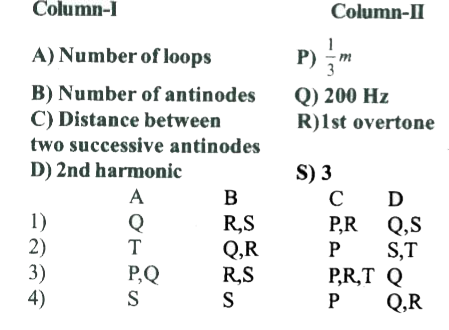Four standing wave segments, or loops, are observed on a string fixed at both ends as it vibrates at a frequency of 140 Hz. What is the fundamental frequency of the string?
23 Hz
28 Hz
35 Hz
47 Hz
The correct Answer is:C
To solve the problem, we need to find the fundamental frequency of a string that is vibrating in the fourth harmonic (4 loops) at a frequency of 140 Hz. Here’s a step-by-step breakdown of the solution:
Step 1: Understand the Harmonics
The string is fixed at both ends, and it is vibrating in the fourth harmonic. The number of loops (or segments) corresponds to the harmonic number (n). In this case, n = 4.
Step 2: Write the Equation for Harmonics
For a string fixed at both ends, the relationship between the harmonic number (n), the wavelength (λ), and the length of the string (L) is given by:
nλ2=L
For the fourth harmonic (n = 4), we can write:
4λ2=L
This simplifies to:
2λ=L
Thus, the wavelength is:
λ=L2
Step 3: Relate Wave Velocity, Frequency, and Wavelength
The wave velocity (v) on the string can be expressed in terms of frequency (f) and wavelength (λ):
v=fλ
For the fourth harmonic, substituting for λ gives:
v=140Hz⋅λ
Step 4: Find the Velocity
From the equation for the fourth harmonic:
λ=L2
We can substitute this into the wave velocity equation:
v=140⋅L2
Step 5: Set Up the Fundamental Frequency Equation
Now, we need to find the fundamental frequency (f₁) when the string vibrates in the first harmonic (n = 1). The relationship for the fundamental frequency is:
1λ12=L
This means:
λ1=2L
Using the wave velocity equation:
v=f1λ1
Substituting for λ₁ gives:
v=f1⋅2L
Step 6: Equate the Two Expressions for Velocity
Now we have two expressions for the wave velocity:
1. From the fourth harmonic:
v=140⋅L2
2. From the fundamental frequency:
v=f1⋅2L
Setting these equal to each other:
140⋅L2=f1⋅2L
Step 7: Solve for the Fundamental Frequency
We can cancel L from both sides (assuming L ≠ 0):
140⋅12=f1⋅2
This simplifies to:
70=2f1
Dividing both sides by 2 gives:
f1=35Hz
Conclusion
The fundamental frequency of the string is 35 Hz.
The string is fixed at both ends, and it is vibrating in the fourth harmonic. The number of loops (or segments) corresponds to the harmonic number (n). In this case, n = 4.
For a string fixed at both ends, the relationship between the harmonic number (n), the wavelength (λ), and the length of the string (L) is given by:
nλ2=L
For the fourth harmonic (n = 4), we can write:
4λ2=L
This simplifies to:
2λ=L
Thus, the wavelength is:
λ=L2
The wave velocity (v) on the string can be expressed in terms of frequency (f) and wavelength (λ):
v=fλ
For the fourth harmonic, substituting for λ gives:
v=140Hz⋅λ
From the equation for the fourth harmonic:
λ=L2
We can substitute this into the wave velocity equation:
v=140⋅L2
Now, we need to find the fundamental frequency (f₁) when the string vibrates in the first harmonic (n = 1). The relationship for the fundamental frequency is:
1λ12=L
This means:
λ1=2L
Using the wave velocity equation:
v=f1λ1
Substituting for λ₁ gives:
v=f1⋅2L
Now we have two expressions for the wave velocity:
1. From the fourth harmonic:
v=140⋅L2
2. From the fundamental frequency:
v=f1⋅2L
140⋅L2=f1⋅2L
We can cancel L from both sides (assuming L ≠ 0):
140⋅12=f1⋅2
This simplifies to:
70=2f1
Dividing both sides by 2 gives:
f1=35Hz
The fundamental frequency of the string is 35 Hz.
Topper's Solved these Questions
- WAVE - IIBOOK - RESNICK AND HALLIDAYCHAPTER - WAVE - IIEXERCISE - PRACTICE QUESTIONS (MORE THAN ONE CORRECT CHOICE TYPE)
6 Videos
- WAVE - IIBOOK - RESNICK AND HALLIDAYCHAPTER - WAVE - IIEXERCISE - PRACTICE QUESTIONS (LINKED COMPREHENSION)
11 Videos
- WAVE - IIBOOK - RESNICK AND HALLIDAYCHAPTER - WAVE - IIEXERCISE - PROBLEMS
59 Videos
- VECTORS BOOK - RESNICK AND HALLIDAYCHAPTER - VECTORS EXERCISE - PRACTICE QUESTIONS
39 Videos
- WAVES-IBOOK - RESNICK AND HALLIDAYCHAPTER - WAVES-IEXERCISE - Practice Questions (Integer Type)
4 Videos
Similar Questions
Knowledge Check
In law of length , the fundamental frequency of vibrating string is
AInversely proportional to vibrating lengthBDirectly proportional to the vibrating lengthCDirectly proportional to the square root of vibrating lengthDInversely proportional to square root of vibrating lengthIn law of tension, the fundamental frequency of vibrating string is
AInversely proportional of square root of tensionBDirectly proportional to the square root of tensionCDirectly proportional to the square of tensionDInversely proportional to densityA standing wave with a number of loops is produced in a stringe fiex at both ends. In this case
Aall particles vibrate in phaseBparticles at all antinodes vibrate in phaseCparticles at alternate antinodes vibrate in phaseDparticles between two consecutive antinodes vibrate in phase
If the frequencies of the sound and fifth harmonics of a string differ by 54 Hz. What is the fundamental frequency of the string ?
View SolutionA violin string vibrates with fundamental frequency of 510 Hz. What is the frequency of first overtone? ( Ans: n1 = 1020 Hz )
View SolutionStanding Waves In A Strings Fixed At Both Ends
View SolutionIn law of linear density, the fundamental frequency of vibrating string is
View SolutionA string has a length of 5 cm between fixed points and has a fundamental frequency of 20 Hz. What is the frequency of the second overtone?
View Solution

